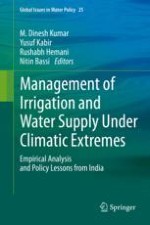This volume provides a theoretical basis for the argument that available research that analyzes the impacts of climate on hydrology, water resources, and water systems, without factoring in the effect of climate variability, are inadequate and often misleading. Also, the book empirically shows that the impacts of climate variability on hydrology and water resources, and irrigation, water supply & sanitation systems are far more pronounced than the likely impacts of future change in climate. The book discusses technological, institutional and policy alternatives for reducing these impacts on various competitive use sectors, especially, irrigation, and water supply and sanitation through case studies of river basins in different hydrological setting.
To set the context, the volume first presents the long term trends in precipitation and temperature in different regions of India, and compares them against inter-annual, inter-seasonal and intra-day variations in climatic parameters, to show how their differential impacts on water resources.
